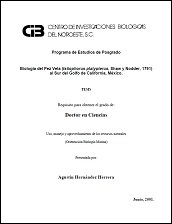PLANEACIÓN Y ORGANIZACIÓN DEL MUESTREO Y MANEJO INTEGRADO DE PLAGAS EN AGROECOSISTEMAS CON UN ENFOQUE DE AGRICULTURA SOSTENIBLE
Sampling planning and organization, and integrated pest management in agroecosystems with a view towards sustainable agriculture
Autor
ENRIQUE TROYO DIEGUEZ
ROSALIA SERVIN VILLEGAS
JOSE GUADALUPE LOYA RAMIREZ
JOSE LUIS GARCIA HERNANDEZ
BERNARDO MURILLO AMADOR
ALEJANDRA NIETO GARIBAY
ALBERTO BELTRAN MORALES
LIBORIO FENECH LARIOS
GUSTAVO ALBERTO ARNAUD FRANCO
Metadatos
Mostrar el registro completo del ítemResumen
" The limited knowledge of the distribution in time and space of pests and crop diseases, as well as of their natural enemies, has lead to the inappropriate use of pesticides that has damaged the environment and human health. Key aspects of the planning and organisation of pest sampling are analysed, with the aim to provide the bases and the eco-entomological information relevant for an adequate use of pesticides, and to contribute to the generation of sustainable agriculture models. For sampling and pest monitoring programmes to be feasible, it is necessary to define two basic stages of the planning: (1) the operational geographic framework, and (2) the performing mechanism or operational instruments. Through this, the tasks and responsibilities of personnel are clearly defined, including involving different institutions and specialists of the region. Accordingly, proposals are made for an adequate planning and organisation of sampling for agricultural pests, resulting in an efficient pest control that is safe for the ecosystem. It is concluded that in order to gain a better coordination among researchers, agencies and institutions involved in the detection and control of pests, it is necessary: (1) to create inter-institutional, regional and international committees to monitor pests and analyse the factors related to the health status of agroecosystems, and (2) to design and develop specific projects for the short and long term solution of phyto-sanitary problems. " " El escaso conocimiento de la distribución temporal y espacial de las plagas y enfermedades de los cultivos, así como de sus enemigos naturales, ocasiona el uso inadecuado de plaguicidas, lo cual ha causado daños al ambiente y a la salud humana. Se analizan aspectos clave para la planeación y organización del muestreo sistematizado de plagas, que tienen como propósito proveer las bases y la información eco-entomológica pertinente para el uso adecuado de los plaguicidas, lo que coadyuva a generar modelos de agricultura sustentable. Para la factibilidad de operación de programas de muestreo y control de plagas, es necesario definir dos etapas fundamentales de su planeación: (1) el marco geográfico operativo, y (2) el mecanismo o instrumento de ejecución. Mediante dichas etapas se definen explícitamente las tareas y responsabilidades de los participantes, mismos que deberán involucrar a diferentes instituciones y especialistas en la región. Por lo anterior, se plantean propuestas para una planificación y organización adecuadas del muestreo de plagas agrícolas, con el fin de que el control de las mismas resulte eficiente e inocuo para el ecosistema. Se concluye que para alcanzar una mayor coordinación entre investigadores, agencias e instituciones involucradas en la detección y control de plagas, debe proponerse y fomentarse: (1) la creación de comités interinstitucionales, regionales e internacionales, para el muestreo sistematizado de plagas y análisis de los factores relativos al estado de sanidad de los agroecosistemas, y (2) el diseño y desarrollo de proyectos específicos para la solución inmediata y a largo plazo de problemas fitosanitarios. "
Colecciones
Ítems relacionados
Mostrando ítems relacionados por Título, autor o materia.
-
PROMOCIÓN DEL PERIFITON PARA EL CULTIVO DE CAMARÓN BLANCO: HACIA UNA ACUICULTURA ECOLÓGICA
DOMENICO VOLTOLINA LOBINA; JUAN MANUEL AUDELO NARANJO; MARIA DEL ROSARIO PACHECO MARGES -
Suelo y Erosión
YOLANDA LOURDES MAYA DELGADO


